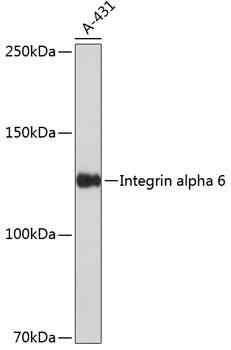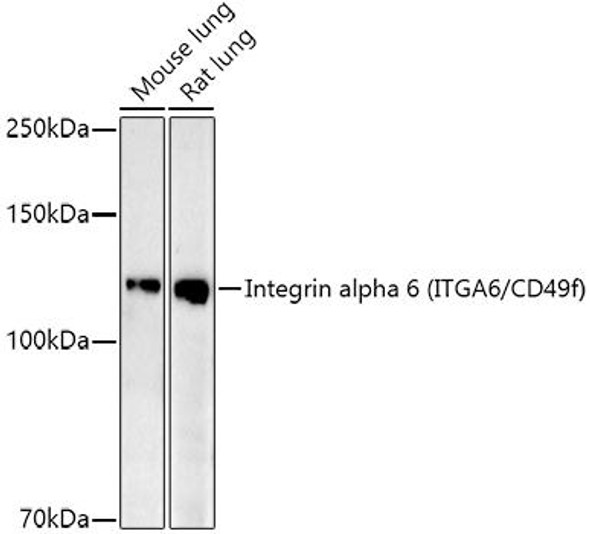Cell Biology Antibodies 17
Anti-Integrin alpha 6 Antibody (CAB19070)
- SKU:
- CAB19070
- Product Type:
- Antibody
- Reactivity:
- Human
- Host Species:
- Rabbit
- Isotype:
- IgG
- Research Area:
- Cell Biology
Description
| Antibody Name: | Anti-Integrin alpha 6 Antibody |
| Antibody SKU: | CAB19070 |
| Antibody Size: | 20uL, 50uL, 100uL |
| Application: | WB |
| Reactivity: | Human |
| Host Species: | Rabbit |
| Immunogen: | A synthesized peptide derived from human Integrin alpha 6 |
| Application: | WB |
| Recommended Dilution: | WB 1:500 - 1:2000 |
| Reactivity: | Human |
| Positive Samples: | A-431 |
| Immunogen: | A synthesized peptide derived from human Integrin alpha 6 |
| Purification Method: | Affinity purification |
| Storage Buffer: | Store at -20°C. Avoid freeze / thaw cycles. Buffer: PBS with 0.02% sodium azide, 0.05% BSA, 50% glycerol, pH7.3. |
| Isotype: | IgG |
| Sequence: | Email for sequence |
| Gene ID: | 3655 |
| Uniprot: | P23229 |
| Cellular Location: | |
| Calculated MW: | 127kDa |
| Observed MW: | 125kDa |
| Synonyms: | CD49f, ITGA6B, VLA-6, Integrin alpha 6, ITGA6 |
| Background: | The gene encodes a member of the integrin alpha chain family of proteins. Integrins are heterodimeric integral membrane proteins composed of an alpha chain and a beta chain that function in cell surface adhesion and signaling. The encoded preproprotein is proteolytically processed to generate light and heavy chains that comprise the alpha 6 subunit. This subunit may associate with a beta 1 or beta 4 subunit to form an integrin that interacts with extracellular matrix proteins including members of the laminin family. The alpha 6 beta 4 integrin may promote tumorigenesis, while the alpha 6 beta 1 integrin may negatively regulate erbB2/HER2 signaling. Alternative splicing results in multiple transcript variants. [provided by RefSeq, Oct 2015] |
| UniProt Protein Function: | ITGA6: Integrin alpha-6/beta-1 is a receptor for laminin on platelets. Integrin alpha-6/beta-4 is a receptor for laminin in epithelial cells and it plays a critical structural role in the hemidesmosome. Heterodimer of an alpha and a beta subunit. The alpha subunit is composed of an heavy and a light chain linked by a disulfide bond. Alpha-6 associates with either beta-1 or beta-4. Interacts with HPS5. Interacts with RAB21. Integrin alpha-6/beta-4 is predominantly expressed by epithelia. Isoforms containing segment X1 are ubiquitously expressed. Isoforms containing segment X1X2 are expressed in heart, kidney, placenta, colon, duodenum, myoblasts and myotubes, and in a limited number of cell lines; they are always coexpressed with the ubiquitous isoform containing segment X1. In some tissues (e.g. Salivary gland), isoforms containing cytoplasmic segment A and isoforms containing segment B are detected while in others, only isoforms containing one cytoplasmic segment are found (segment A in epidermis and segment B in kidney). Belongs to the integrin alpha chain family. 8 isoforms of the human protein are produced by alternative splicing. |
| UniProt Protein Details: | Protein type:Motility/polarity/chemotaxis; Membrane protein, integral; Receptor, misc.; Cell adhesion Chromosomal Location of Human Ortholog: 2q31.1 Cellular Component: cell surface; focal adhesion; plasma membrane Molecular Function:insulin-like growth factor I binding; protein binding Biological Process: cell-substrate adhesion; cell-substrate junction assembly; extracellular matrix organization and biogenesis; gut development; hemidesmosome assembly; leukocyte migration; positive regulation of apoptosis; positive regulation of GTPase activity; positive regulation of phosphorylation; positive regulation of transcription from RNA polymerase II promoter; skin development Disease: Epidermolysis Bullosa Junctionalis With Pyloric Atresia |
| NCBI Summary: | The gene encodes a member of the integrin alpha chain family of proteins. Integrins are heterodimeric integral membrane proteins composed of an alpha chain and a beta chain that function in cell surface adhesion and signaling. The encoded preproprotein is proteolytically processed to generate light and heavy chains that comprise the alpha 6 subunit. This subunit may associate with a beta 1 or beta 4 subunit to form an integrin that interacts with extracellular matrix proteins including members of the laminin family. The alpha 6 beta 4 integrin may promote tumorigenesis, while the alpha 6 beta 1 integrin may negatively regulate erbB2/HER2 signaling. Alternative splicing results in multiple transcript variants. [provided by RefSeq, Oct 2015] |
| UniProt Code: | P23229 |
| NCBI GenInfo Identifier: | 519668687 |
| NCBI Gene ID: | 3655 |
| NCBI Accession: | P23229.5 |
| UniProt Secondary Accession: | P23229,Q08443, Q0MRC7, Q14646, Q16508, Q53RX7, Q59HB7 B2RMU9, B4DG69, B4DKB8, C4AM96, G5E9H1, |
| UniProt Related Accession: | P23229 |
| Molecular Weight: | 122,358 Da |
| NCBI Full Name: | Integrin alpha-6 |
| NCBI Synonym Full Names: | integrin subunit alpha 6 |
| NCBI Official Symbol: | ITGA6 |
| NCBI Official Synonym Symbols: | CD49f; VLA-6; ITGA6B |
| NCBI Protein Information: | integrin alpha-6 |
| UniProt Protein Name: | Integrin alpha-6 |
| UniProt Synonym Protein Names: | CD49 antigen-like family member F; VLA-6; CD_antigen: CD49f |
| Protein Family: | Integrin |
| UniProt Gene Name: | ITGA6 |
| UniProt Entry Name: | ITA6_HUMAN |







